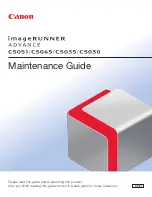
January 2001 © TOSHIBA TEC
5 - 3
GD-1060 CIRCUIT DESCRIPTION
The scanner unit has the exposure lamp’s light irradiated to the original placed for transmission. At this
time, it converts the light reflected from the original into electrical signals through the CCD. Then the
A/D converter (IC3) converts the electrical signals into digital signals. The scanner control GA (IC11)
converts them into parallel signals and processes them for correction, converts them into raster data
(digital image data), and sends it to the scanner I/F of the PTC GA (IC36).
The raster data is arranged in words (16 bits) by the scanner I/F and transferred in DMA mode to the
PIX-SDRAM (IC9, IC13, IC15, IC19) where it is stored. During this period, this machine also commu-
nicates with the destination and determines the coding method for transmit data.
The raster data is transferred in DMA mode through the CODEC I/F-1 of the PTC GA to the CODEC
(IC1) installed on the FAX PWA. Then the CODEC converts the raster data into the coded data (MH,
MR, MMR or JBIG) to meet the destination.
The coded data is transferred in DMA mode through the CODEC I/F-1 to the system-SDRAM (IC32)
where it is stored.
The coded data is transferred in DMA mode to the MODEM (IC4) installed on the FAX PWA. Then the
MODEM modulates the coded data into analog signals for the telephone line.
The analog signals are sent to the telephone line network through the NCU PWA. Then the data of the
original is transmitted to the destination through the telephone line network.





































